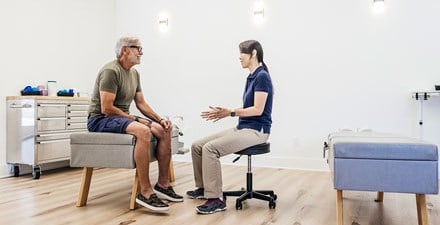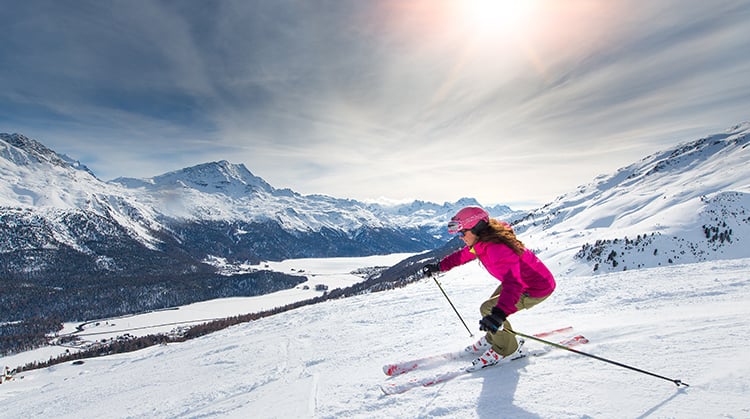
Most skiing injuries happen to the lower limb, most commonly the knee. And while the use of releasable bindings has decreased the rate of leg fractures by 90% in the past 30 years, knee sprains are on the rise. Knee injuries such as ACL and MCL tears account for about 30% of all skiing injuries.
The most common injury is a medial collateral ligament tear. It is typically treated without surgery. The MCL can be torn when a skier falls down hill while their ski tips are pointed toward one another in a snowplow position (a common slow or stop position). MCL tears are more common among beginners and intermediate skiers than advanced and elite skiers.
You may be able to prevent an MCL tear during skiing by:
- Making sure that your weight is balanced when you are in the snowplow position.
- Sticking to terrain that is a comfortable challenge but not overwhelming.
The second most common injury is an anterior cruciate ligament tear. The ACL is very important to the functional stability of the knee. As such, ACL tears often require surgery (however some people can avoid surgery). ACL tears are common in sports, but most are the result of "non-contact" injuries.
There are two ways that skiers most commonly tear the ACL:
- Landing a jump in poor form. If you land with your weight back, so the back of the boot is pushing on the calf, this produces a force that can tear the ACL. The best way to avoid this injury is to learn to land safely, with your weight forward. Start with simple jumps and gradually advance to more difficult jumps.
- The "phantom foot" phenomenon often happens when skiers try to stand up to avoid an inevitable fall. All the weight goes on the outside of one ski, and the arms and trunk rotate away from that leg. When a skier falls this way, an ACL injury is often the result. Never try to stand up during a fall. It is better to "go" with the momentum of a fall and maintain good ski technique.
Preventing Injury on the Slopes
- Remember the keys to effective skiing technique: Keep your hands and weight forward, your legs parallel, and and your hips, knees, and ankles flexing equally.
- Stay on marked trails: Going off-trail can take you into rugged territory with many possible obstacles (such as trees and rocks). These can contribute to injuries.
Getting Ready for the Slopes
- Prepare your body. Three to four weeks of aerobic training such as walking or riding an elliptical machine or bike are great ways to get you ready for a full day on the slopes. Also, a few simple strengthening exercises (listed below) can prepare your core and legs for skiing.
- Ensure you have proper equipment: Make sure ski boots, bindings fit, and your ski length is appropriate for your height and skill level. Always wear a helmet. Wrist guards are a good idea if snowboarding.
- Learn proper technique: Take a skiing class with a professional before you hit the slopes.
- Rest: If you are tired, rest. Injuries happen more often when skiers are fatigued.
Exercises to Condition Your Core and Lower Extremities
The exercises below are not intended as a substitute for care from a health care professional. If you experience pain or other symptoms of injury or pain, you should seek the advice of a physical therapist or your primary care provider.
Double Leg Squats
Place your feet shoulder width apart. Squat down, keeping your heels on the floor. Keep your feet and knees facing forward. Stick your bottom out and don't let your knees go too far forward. Focus on using your gluteal muscles (buttock muscles) to lift and lower your weight. Your shins should be parallel to one another with your knees no farther forward than your toes, just like in good skiing technique. Do 10-15 repetitions, then hold midway in the squat until you are fatigued. Repeat 3 times.
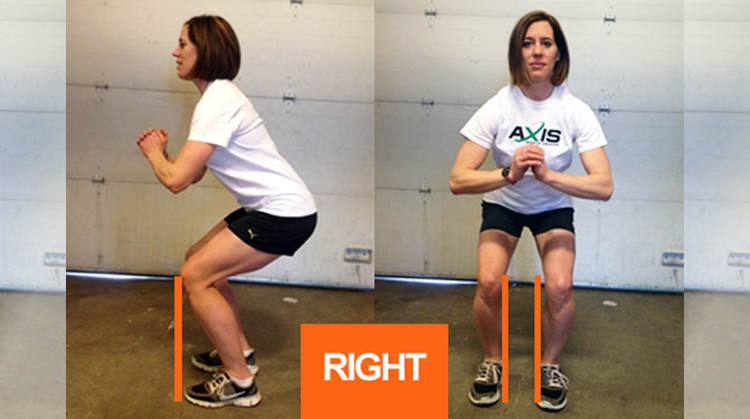
Above: Double leg squats with good form. Even though she is driving her hips backward, she stays balanced over her feet and is not falling backward.
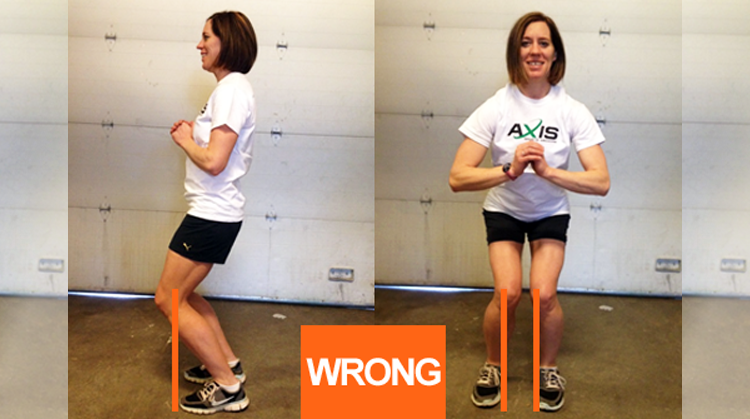
Above: Double leg squats with poor form. The knees are knocked inwards, and she is driving her knees forward instead of lowering her hips backward.
Single-Leg Squats
Stand on one leg. Place your hand or a few fingers on a chair or counter to for balance if needed. Work towards squatting without holding on. Keep your pelvis level and squat down. Just like in the double leg squat, keep your heel on the ground with your foot and knee facing forward. Make sure your pelvis is level (so it doesn't drop down on the unsupported leg). Do 10-15 repetitions on each leg, and repeat 3 times.
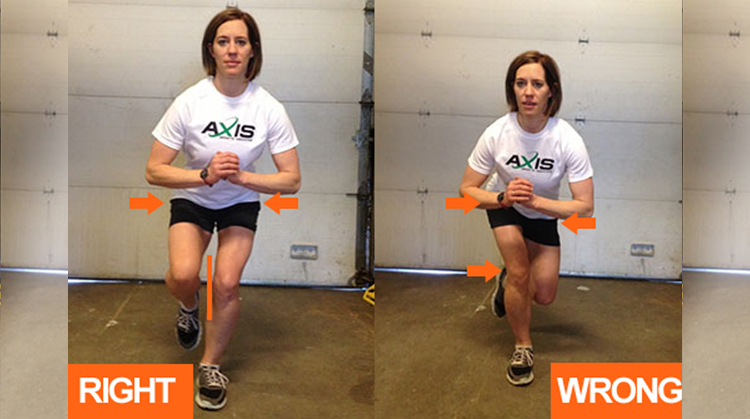
Above Left: Single leg squat in good form. The model is flexing her hip, knee, and ankle equally and keeping her knee forward and her leg perpendicular with the ground. This will strengthen her leg, promote good ski technique, and teach her to avoid a dangerous position.
Above Right: Single leg squat in poor form. The model is letting her pelvis drop and her standing knee fall inwards. This is a component of the "phantom foot" position and should be avoided.
Side-to-Side Skaters
Stand on one leg and take a large step to the side with your other leg. Stand on that leg, and then take another large step back to where you were. Make sure that your pelvis stays level and that your knee doesn’t buckle inward. You can make this more difficult by wrapping a resistance band around your waist. Work up to doing this for 2 minutes. Don't rush. The slower you go, the more difficult this exercise is.
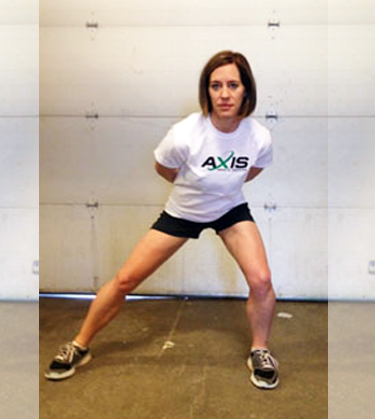
Side plank
Lie on your side with your knees bent, and prop up on one elbow. Lift up your hips and push them forward, so you make a straight line from your shoulders to your knees. Slightly lift the top leg up. You should feel this working your hip and core muscles on the side that is down. These are the muscles that keep your knee from falling inwards. Make the exercise more difficult by starting with your knees straight so only your forearm and the outside of your foot are touching the ground.
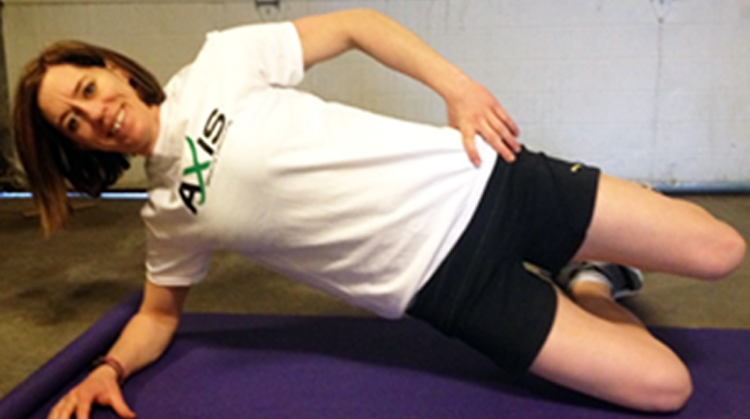
Sometimes despite the best efforts injuries still happen. If you experience a skiing injury, a physical therapist can design a treatment program specific to your injury to help you get back on the slopes.
Physical therapists are movement experts. They improve quality of life through hands-on care, patient education, and prescribed movement. You can contact a physical therapist directly for an evaluation. To find a physical therapist in your area, visit Find a PT.


